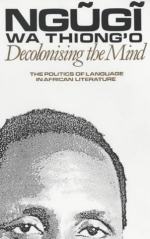
|
| Name: _________________________ | Period: ___________________ |
This test consists of 15 multiple choice questions and 5 short answer questions.
Multiple Choice Questions
1. Where was gunpowder invented?
(a) The Americas.
(b) China.
(c) Africa.
(d) Europe.
2. What was the author's earliest short story, which was published in the literary journal at Makerere University College?
(a) "The Sand Dune."
(b) "The Fig Tree."
(c) "The Waving Wheat."
(d) "The Officer."
3. In what language was Hekaya Za Abunuwasi written?
(a) Ashanti.
(b) Kiswahili.
(c) Hausa.
(d) Jalaa.
4. Who is the protagonist in Cry, the Beloved Country?
(a) Nyakinyua.
(b) Nderi wa Riera.
(c) Wanja.
(d) Stephen Kumalo.
5. What metaphor does the author present to describe the differences of perception in Chapter 4, Part I?
(a) The seven warriors on the cliff.
(b) The seven rings of the prince.
(c) The seven snakes and the snake handler.
(d) The seven blind men and the elephant.
6. What character in Caitaani mũtharaba-Inĩ moves in a matatu taxi from Nairobi to Ilmorog?
(a) Warĩĩnga.
(b) Abdulla.
(c) Munira.
(d) Nyakinyua.
7. Who is described in Chapter 4, Part IX as a German visionary how the money taken from the worker and the poor had come to dominate human relations?
(a) Bertolt Brecht.
(b) Gabriel Okara.
(c) Karl Marx.
(d) Gakaara wa Wanjaũ.
8. The author asserts in his conclusion in Chapter 4, Part IX that what this book on the politics of language in African literature is really about is what?
(a) The communication of struggle throughout history.
(b) The unity of different languages and cultures.
(c) The salvation of the African schoolchild.
(d) National, democratic, and human liberation.
9. What essay from the book Writers in Politics does the author describe in Chapter 4, Part III?
(a) "Literature and Society."
(b) "Performance of Literature and Power."
(c) "Literature in Production."
(d) "The Struggle for Cultural Freedom."
10. Who invented mathematical science?
(a) The Arabs.
(b) The Kikuyu.
(c) The Chinese.
(d) The Europeans.
11. Who does the author attribute with changing language all the time?
(a) The petty-bourgeoisie.
(b) The upper and royal classes.
(c) The intellectual elite and educators.
(d) The peasantry and working class.
12. What was the student literary journal at Ibadan University College?
(a) Kĩgũũnda.
(b) Penpoint.
(c) Horn.
(d) Pen and Ink.
13. In what language did Fumo Liyongo write?
(a) Gĩkũyũ.
(b) Hausa.
(c) Swahili.
(d) Jalaa.
14. What was the author's fourth novel in English?
(a) Petals of Blood.
(b) Weep Not, Child.
(c) The River Between.
(d) A Grain of Wheat.
15. Who wrote the novel Mister Johnson?
(a) Karen Blixen.
(b) Nderi wa Riera.
(c) Bob Dixon.
(d) Joyce Cary.
Short Answer Questions
1. By what number was Ngũgĩ wa Thiong’o called in prison?
2. Who is the author of Out of Africa?
3. Who was the military dictator and President of the Democratic Republic of the Congo/Zaire from 1965 to 1997?
4. In the author's analysis of the philosophical base of a person's perspective in Chapter 4, Part VII, he asks whether a person's standpoint is idealist or what?
5. Who is the author of Imperialism, the Highest Stage of Capitalism?
|
This section contains 464 words (approx. 2 pages at 300 words per page) |

|




